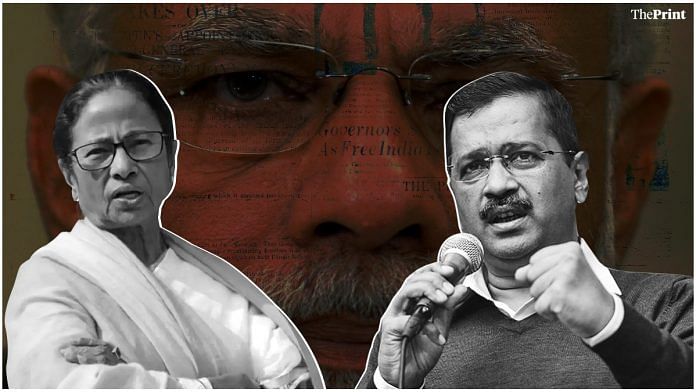The next battle in India isn’t an electoral one but one of political positioning. It will be fought between West Bengal Chief Minister Mamata Banerjee and Delhi Chief Minister Arvind Kejriwal. Both want to be the mobilising force against Prime Minister Narendra Modi. At this point, what is more politically instructive than the 2024 Lok Sabha election is such fights ahead of 2024.
The question isn’t whether Kejriwal and Banerjee can take on Modi. It’s how their armoury is stocked up. Instead of the clichéd David-vs-Goliath war, imagine if there were two audacious, over-confident Davids who face-off first.
The national scramble for a political alternative to Modi has gained both traction and desperation since 2014, but the race now appears to be narrowing. The 1990s were all about the post-poll arithmetic of a stitched-up anti-Bharatiya Janata Party (BJP) front. But arithmetic alone doesn’t work, you need a politician who can rule the algorithms in today’s attention economy.
And CM Banerjee and CM Kejriwal know the art of ‘attention-based politics’, just the way Modi does. They are also aggressive enough to aspire for a second state — Punjab and Goa (or Tripura, whichever comes first for TMC). You see, Modi’s rise has given an arc of ambition to India’s chief ministers.
Also read: Modi at 71 has zero challenge. But one CM is emulating him, a divisive, rising BJP star
CM to PM
After Deve Gowda, it took nearly two decades for a chief minister to come to Lutyens’ Delhi as PM. But 2014 was the first time a chief minister was fuelled by audacity and winner-takes-all politics. It’s only natural that other CMs probably see this as a template to follow. Arvind Kejriwal and Mamata Banerjee have the same four traits that Modi displayed ahead of 2014 – ambition, audacity, early-mover advantage and hustle. Of course, none of these add up to a neat total of a ‘PM chair’. For that you need the support of a party with a wide base. Neither has it. And Kejriwal is less likely than Mamata to have the ‘glue factor’ for an opposition alliance.
But the key similarities and differences between the two Davids make their self-propelled engines fascinating to watch.
Same and different
Both Kejriwal and Banerjee have supported the biggest and longest-running mass movement against the Modi government, the farmers’ agitation in three states. They have tried to be anti-Modi without being seen as being anti-Hindu – from free Ayodhya pilgrimages, Diwali aarti, Chandipath to temple hopping. While Mamata Banerjee is a Left-slayer in West Bengal, Kejriwal has scrupulously stayed away from Left politics in Delhi. Both are called ‘mini-Modis’ by critics for their style of functioning.
But there are many differences.
Kejriwal’s advantage in crafting a national image is that he is not seen as a boxed-in regional leader like Mamata or Akhilesh Yadav, Uddhav Thackeray, K. Chandrashekar Rao, or M.K. Stalin are. Delhi’s mixed cosmopolitanism prevents Kejriwal’s image from being restricted to any particular community. Mamata, however, is largely viewed as a daughter-of-the-soil, Bangla-speaking CM. But here’s a corollary. Mamata’s biggest edge is that there are Bangla-speaking pockets in at least six states. If she picks Lok Sabha seats from most of them, she can flex.
Mamata’s secret weapon is strategist Prashant Kishor and she’s already ruling the optics in terms of engineering defections, claiming billboards and generating public chatter. Just a year ago, most political observers would have given this attention to Kejriwal’s Aam Aadmi Party because of his participation in the last Goa polls.
While Mamata’s Muslim politics is in your face, Kejriwal’s is more ambivalent.
On sensitive issues of national security, Kejriwal plays it closer to the BJP. He supported the revocation of Article 370 in Kashmir. Mamata, on the other hand, claimed the decision had tarnished India’s name globally.
We also need to dissect the processes the two CMs follow to garner national spotlight — while Mamata Banerjee bites back against any major move or comment by Modi, Kejriwal uses strategic silence when it comes to the Prime Minister.
However, there is one thing that Kejriwal has that Mamata doesn’t. He is already the main opposition in Punjab assembly, and he just won impressively in the Surat municipal polls in Gujarat this summer. His national ambitions are a tad older than Mamata’s.
Also read: BJP vs opposition is just like Coke vs Pepsi. Catch-up Hindutva won’t work
Election afterglow
Of course, a lot depends on who captures the bigger chunk of the national imagination and conversation. As Yashwant Deshmukh of C-Voter said in a recent TV show, after Modi and Rahul Gandhi, the state leader who gets the highest ratings is Kejriwal, not Mamata.
How they create a new image of a national leader now will give us a clue on how the anti-Modi ecosystem works ahead of 2024. It is a difficult race —as seen in Rahul Gandhi’s failing experiment — even though there are opportunities for leaders to rise.
The new buzz around Mamata is only because she is still basking in the post-Bengal election win afterglow. Not unlike the one Kejriwal enjoyed after the 2015 Delhi win. Lest we forget, Kejriwal lost Goa and Punjab, even though he was also catapulted to the high stakes game the same way Mamata is today.
But as we learned in US politics, the ‘audacity of hope’ is a good starting point.
Rama Lakshmi is the Opinion and Features Editor at ThePrint. She tweets @RamaNewDelhi. Views are personal.
(Edited by Neera Majumdar)



